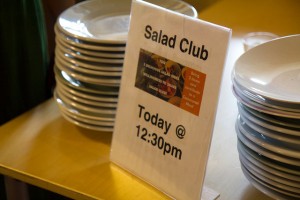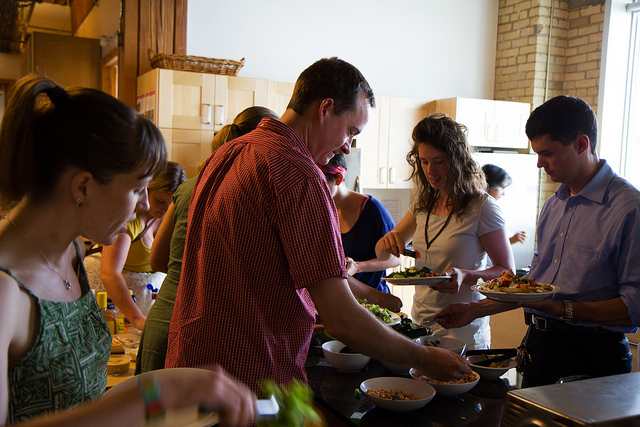Last week I led a session at PeopleFocus, an HR conference, focused on collaboration, for credit union professionals. One of the keynote speakers was Tonya Surman, CEO of the Centre for Social Innovation (CSI), Canada’s premier co-working space for social entrepreneurs. Her mention of the CSI ‘Salad Club’, and its role in building a culture of collaboration, and innovation, hit me as a reminder about the power of place and food.
Salad Club is a space in CSI where tenants regularly come together and co-create a salad bar to share with each other. The Salad Club concept is not unique to CSI, though certainly they are an influential advocate of its application, in an intentional way.
Community kitchens as place-making
Community kitchens are shared spaces where one thing leads to another.
- shared spaces create collisions
- collisions lead to connections
- connections ignite ideas
- ideas lead to collaboration and partnership; the Powers of Two
- partnership leads to innovation
Place is foundation for community. Food builds momentum.
Community kitchen design
In community kitchen design:
- Size matters. The kitchen isn’t a hole in the wall. It’s not there as a money maker. “We do big, open kitchens because kitchens are gathering and meeting points for people.”
- Kitchen islands spur interaction. “Instead of people facing a wall to chop the vegetables, we have them facing each other.”
Backing up a step – before the kitchen comes the building. “New ideas need old buildings” said Jane Jacobs. In a city, new buildings are too risky, when the success margin of a new idea is so small. And besides, old buildings are (hopefully) welcoming, soulful, and authentic. Plus, there can be ‘comfort in chaos’.
Design helps spur collaboration.
More community kitchen success factors
Opt for the potluck format. Potlucks provide an opportunity to contribute, and be appreciated (our greatest psychological need). Creating your own dish builds connection in more ways than one. It mitigates convenience, and our loss of connection and relationship, to our food.
Make it a regular, scheduled happening; your food together time. There is nothing more important in a high-context workplace than ritual and tradition. Make your collaboration high-context, and relationship-based.
What’s your community kitchen?
The Salad Club is one approach, in one context. Here’s another I’m familiar with. What’s your favourite approach, using food, as a regular way to build a culture of collaboration, serendipity, and inspire your people and organization?
—————-
Images: ChrisLuckhardt.com (on Flickr)



Speak Your Mind